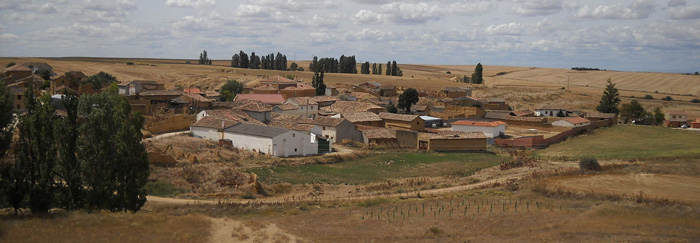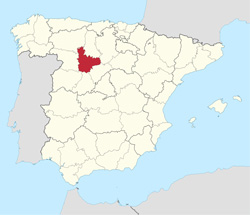Valladolid in Valladolid

The province of Valladolid is situated in the centre of the autonomous region of Castilla y León in northeastern Spain. It enjoys the distinction of being the only Spanish province which is surrounded exclusively by other provinces of the same region: Burgos, Palencia, León, Salamanca, Avila, and Segovia. It is also the only province in Spain which is completely void of mountains. Nonetheless, its average height above sea level is 700 m – compared to for example Great Britain, where it is 75 m.
 The province has been populated since pre-Roman times, although it has never been a very densely populated area. The average population density in Spain is 94 inhabitants per km2, in Valladolid it is less than 65. The population in 2020 constituted just over 1% of the total of people living in Spain, situating it 29th of the 50 Spanish provinces. The capital of Valladolid is Valladolid. It is home to almost 300,000 souls.
The province has been populated since pre-Roman times, although it has never been a very densely populated area. The average population density in Spain is 94 inhabitants per km2, in Valladolid it is less than 65. The population in 2020 constituted just over 1% of the total of people living in Spain, situating it 29th of the 50 Spanish provinces. The capital of Valladolid is Valladolid. It is home to almost 300,000 souls.
The region of Castilla y León does not have an official capital, but being the seat of the region’s courts and government, the city considers itself the capital of Castilla y León. In fact, from 1601 to 1606 Valladolid was the capital of the whole Empire of Spain.
Valladolid has other claims to fame: Here, Ferdinand III (known as Saint Ferdinand) was proclaimed king, the Catholic Majesties’ wedding took place in Valladolid, Henry IV, Philip II, Philip IV and Ana de Austria (queen of France) were born here. In Valladolid, Magellan planned the first travel around the world, in which he discovered the natural passage between the Atlantic and Pacific oceans which is now known as the Strait of Magellan. Christopher Columbus died and was buried in Valladolid before his earthly remains were moved to Seville, and Miguel de Cervantes finished writing the novel that was to become a point of reference for all students of literature: Don Quixote.
The Easter Week celebrations in Valladolid are amongst the most spectacular and visited in Spain, and the city is home to several museums, including the homes of the poet José Zorilla, Christopher Columbus, and Miguel de Cervantes. Its historic centre houses an abundance of palaces, noble houses, churches, plazas, avenues, and parks as well as the majority of the city’s museums.
The daily temperatures in Valladolid vary a lot between night and day, often with as much as 20 degrees difference. The annual average temperature is 12.7ºC. The winters are cold with frequent fogs and frosts – there is an average of 56 days with below zero temperatures a year. It snows an average of nine days a year. The fog that is produced during the long December and January nights often does not disperse all day, and hoarfrost is a frequent visitor in the winter months. The summers, on the contrary, are hot and dry with maximum temperatures between 30 and 35ºC, although the nights are usually mild and comfortable with an average minimum temperature of 14ºC.
Although Valladolid is several hundred kilometres from the coast, it nonetheless boasts its own beach, Playa de las Moreras. It is an artificial beach with a large area of sand leading down to the Pisuerga River which traverses the city. There, the city folk can sunbathe and frolic, and even have a swim in the river.
Although the province’s economy is very much dominated by agriculture and livestock production due to the flatness of the land, Valladolid Capital has only 1% of its working population employed in these sectors. The largest economic sector in the city is the services sector which employs almost 105,000 people, 72.7% of the registered work force. Within the services sector, the retail trade of non-comestible products presents over 50% of the total. The industry and construction sector is also an important player in the city’s economy giving jobs to just over 22,000 workers.


